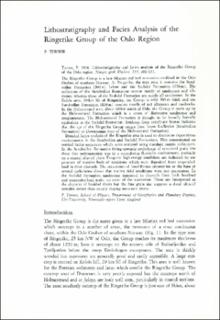| dc.contributor.author | Turner, P. | |
| dc.coverage.spatial | 17132 Porsgrunn | |
| dc.coverage.spatial | 18144 Lier | |
| dc.coverage.spatial | 18153 Hønefoss | |
| dc.coverage.spatial | 18152 Oppkuven | |
| dc.coverage.spatial | VIKEN | |
| dc.coverage.spatial | HOLE | |
| dc.coverage.spatial | RINGERIKE | |
| dc.coverage.spatial | VESTFOLD | |
| dc.coverage.spatial | LIER | |
| dc.date.accessioned | 2020-08-26T13:13:33Z | |
| dc.date.available | 2020-08-26T13:13:33Z | |
| dc.date.issued | 1974 | |
| dc.identifier.uri | https://hdl.handle.net/11250/2674994 | |
| dc.description.abstract | The Ringerike group is a late Silurian red bed succession confined to the Oslo Graben of southern Norway. At Ringerike, the type area, it contains the Sundvollen Formation (500 m) below and the Stubdal Formation (750 m). The sediments of the Sundvollen Formation consist mostly of sandstones and siltstones, whereas those of the Stubdal Formation are nearly all sandstones. In the Kolsås area, 20 km SE of Ringerike, the Group is only 500 m thick and the Sundvollen Formation (100 m) consist mostly of red siltstones and mudrocks. In the Holmestrand area, about 60 km south of Oslo, the Group is made up by the Holmestrand Formation which is a series of distinctive sandstones and conglomerates. The Holmestrand Formation is thought to be broadly laterally equivalent to the Stubdal Formation. Evidence from vertebrate faunas indicates that the age of the Ringerike Group ranges from lower Ludlovian (Sundvollen Formation) to Downtonian (top of the Holmestrand Formation). Detailed facies analysis of the Ringerike area is used to determine depositional environments in the Sundvollen and Stubdal Formations. This concentrated on vertical facies sequences which were analysed using standard matrix techniques. | |
| dc.language.iso | eng | |
| dc.relation.ispartofseries | NGU (314) | |
| dc.rights | Navngivelse 4.0 Internasjonal | |
| dc.rights.uri | http://creativecommons.org/licenses/by/4.0/deed.no | |
| dc.subject | SEDIMENTÆR BERGART | |
| dc.subject | FACIES | |
| dc.subject | PALEOZOIKUM | |
| dc.subject | STRATIGRAFI | |
| dc.subject | PETROGRAFI | |
| dc.subject | SEDIMENTASJON | |
| dc.title | Lithostratigraphy and facies analysis of the Ringerike group of the Oslo region. | |
| dc.type | Journal article | |
| dc.description.localcode | 36360 | |
| dc.source.pagenumber | 101-131 | |

